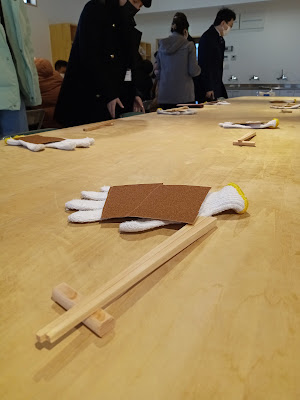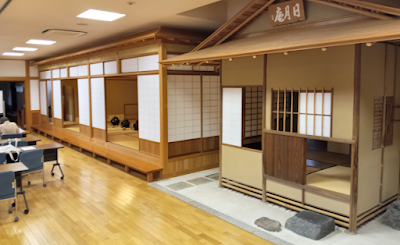Day 12, (free Saturday) early Tomo-uke Daijingu visit and reflections
 |
| pond south of Geku main shrine, empty ground adjacent to main shrine, Tsuchino kami shrine |
The image of a murky pond whose smooth surface gives a glimpse of something much bigger and more beautiful (left photo) is one metaphor of religious culture: daily life is messy and disappointing as a matter of course, but thanks to the traditions of respect and worship (worth-ship) a person can glimpse bigger and brighter things. The middle and right-hand photos illustrate the idea that humans create ideas, organizations, symbols and words, as well as buildings and (culturally meaning-filled) landscapes as a kind of scaffolding that allows them to climb off the ground and build even more ideas and imagination. Institutional religion is this sort of supporting framework to allow people to grow and engage with the ideas and teachings. But those human-made things (the rope boundaries, stone steps, white and black fields of stones) are not the kami or the religious core. Deities may instead be without form and limitation. But mortal minds require outlines, silhouette, or definite shape and location to focus. Hence we see boundaries, shapes, geometry, and defined space and time. But to be content in knowing those visible elements of a shrine or worship building, rituals, dance, music, and so on is a very tiny connection to something much bigger and fascinating.
Looking around at the other Geku shrine visitors before 7 a.m. on Saturday morning, there is no way to know what joy or sorrow or ordinary things could be on their minds; what their expectation might be for paying respects at the shrine(s); or what direct or later effect will result from their decision to come here. But using one's imagination, it is possible to suppose that many are content to do the standard sequence of paying respects (with or without offering cash at the same time): 3 bows, 2 hand claps [2 deep bows, 2 hand claps, final bow to take one's leave]. Without reflecting on the kami in all of the Ise Jingu history and ups and downs across the generations and events in Japan and the bigger world, perhaps this morning's visitors "check the box" of conforming to standard forms of paying respects, not quite testing or exercising their faith, but able to enter into a position of ambivalence - thinking that maybe there is effect for one's actions, maybe not; possibly there is effect which one fails to notice but which is consequential despite that. The quick walking pace of some give the impression of "mission accomplished" - of having a goal to arrive, pay respects, leave. A very few walked at a slower than normal pace, seemingly very deliberate in their forward progress. In summary, all religious traditions -ancient and newer forms, too- include the universal tension between the scaffolding (external structures, calendars, expectations, habits) and the raw encounter with the divine that goes far beyond any human organizations and protocols. As well, there is the challenge of "holding lightly" (rather than gripping excessively) a posture and attention cued to matters spiritually overlaying the normal "maximizing utility" (homo economicus). In other words, even a religious expert like a priest or a devoted lay leader cannot always be praying and looking past human things to see the divine part, moment by moment.
On this early morning visit to the Outer Shrine of Ise Jingu, the quiet and late winter chill encourage such wonderings about busy modern life and the way that religious matters touch those living through the social changes now. Do clergy and parishioners, indeed foreign visitors, see through the human-made accumulated practices and glimpse something more divine? And how often do clergy or parishioners enter into a habit of seeing and noticing things that go beyond the everyday? No answer is forthcoming, but to ask the question has meaning of its own.


Comments
Post a Comment